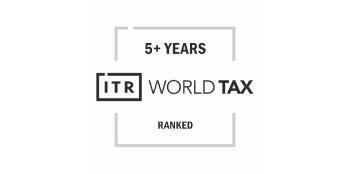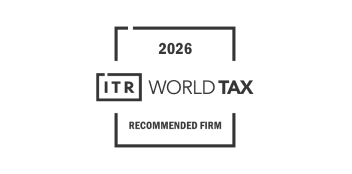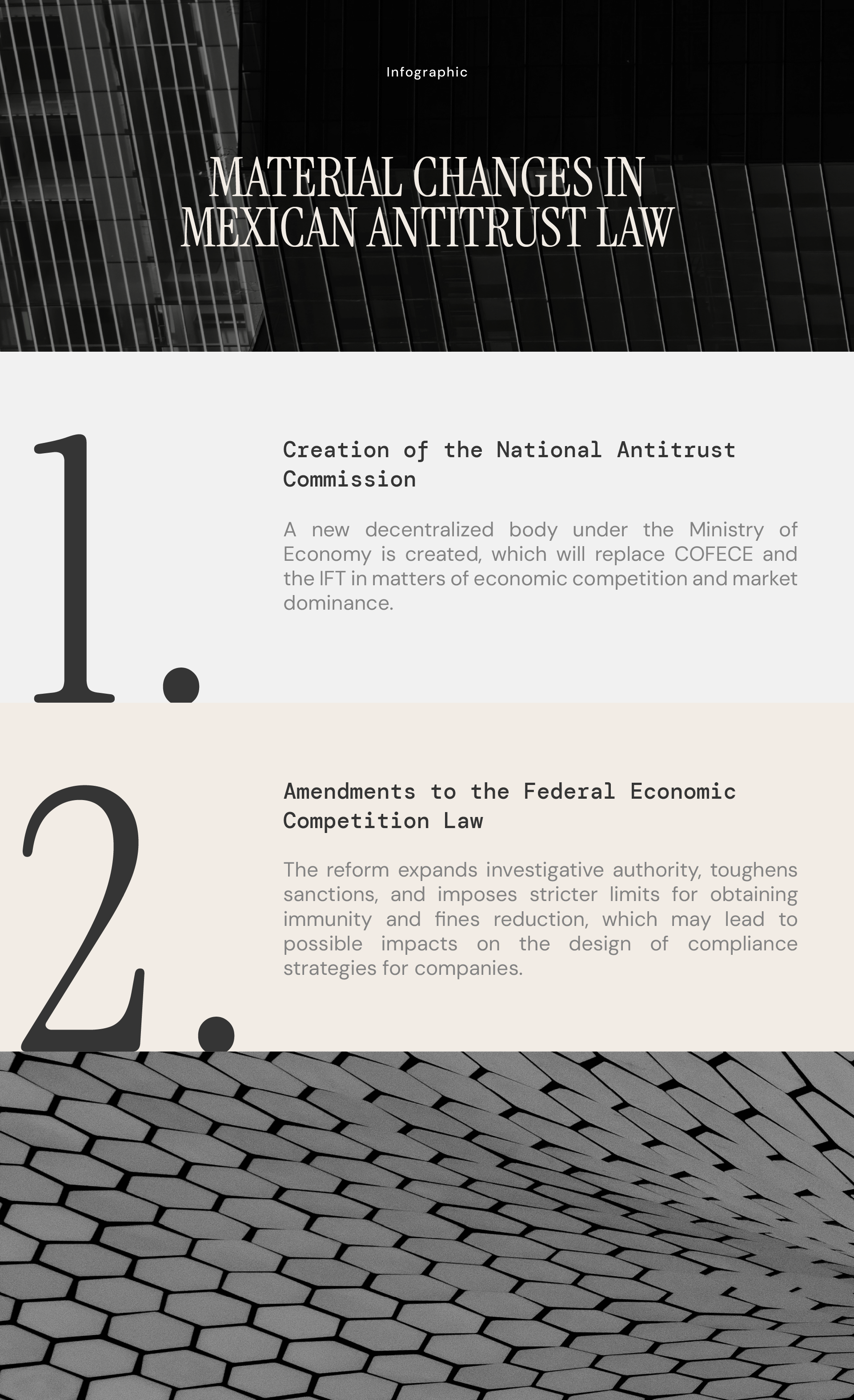
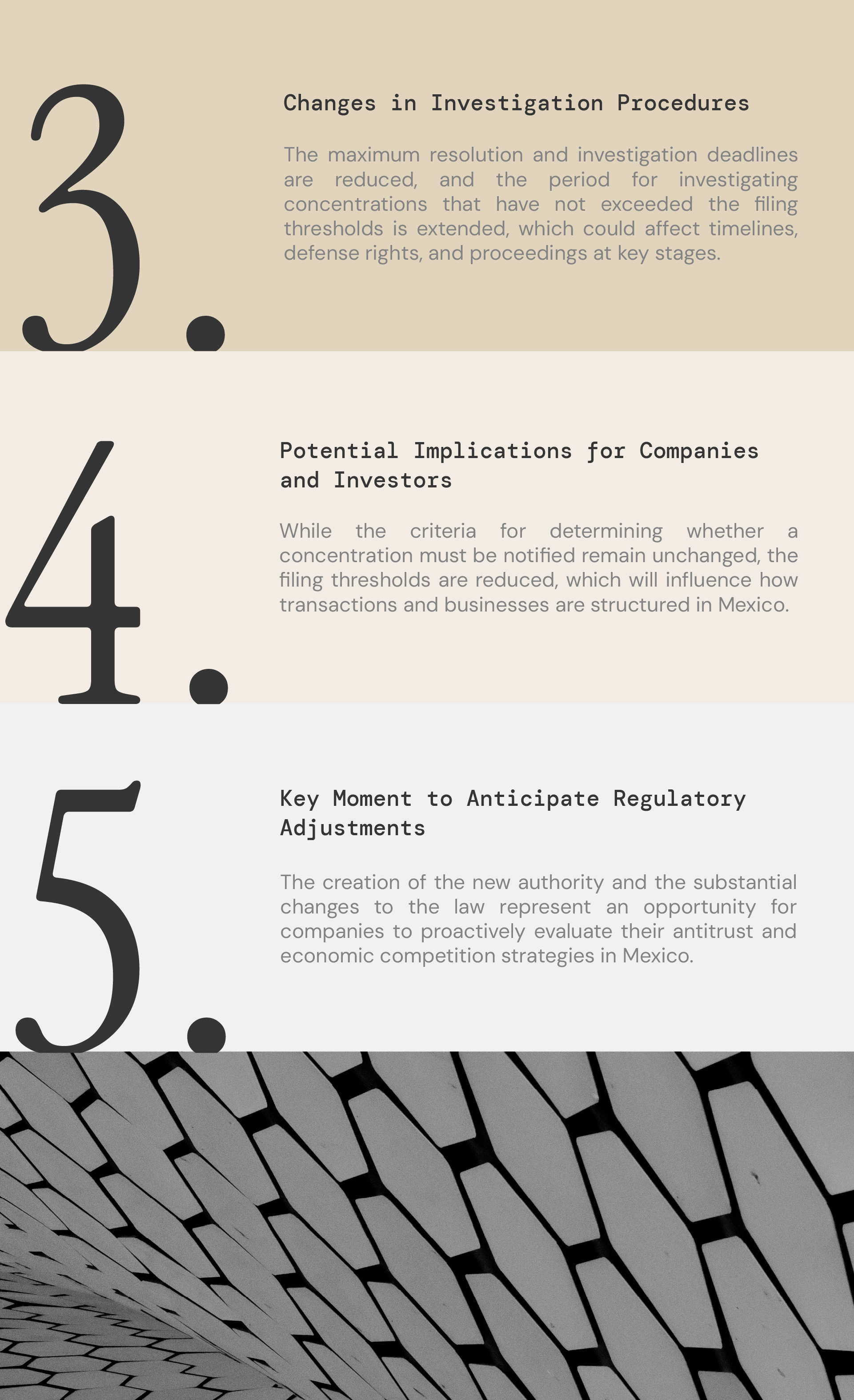

On June 30, 2025, the Congress of the Union approved a reform to the Federal Law on Economic Competition (the “LFCE”) that replaces the Federal Commission on Economic Competition (“COFECE”) and the Federal Institute of Telecommunications (“IFT”) [with regard to its powers in matters of economic competition and preponderance], with the National Antimonopoly Commission (“CNA”), a new decentralized body of the Ministry of Economy (the “Reform”).
The Reform will take effect the day after its publication in the Official Gazette of the Federation. However, COFECE and IFT will remain in office until, in the case of COFECE, the Plenary of the CNA is integrated and, in the case of the IFT, the plenary of the Telecommunications Regulatory Commission (“CRT”) is integrated.
The most relevant aspects of the Reform are detailed below:
1. The criteria for determining whether a concentration should be notified to the CNA are maintained, but the thresholds are lowered (approximately between 11% and 17%) to look as follows [exchange rate 19 MXN for 1 USD]:
(i) When the act or succession of acts that give rise to them, regardless of the place of their celebration, amounts to the national territory, directly or indirectly, an amount greater than the equivalent of sixteen million times [i.e. MXN 1,810,240,000 or approximately USD 95,275,789.47] the daily value of the current Measurement and Update Unit (“UMA”);
(ii) When the act or succession of acts that give rise to them involves the accumulation of thirty percent or more of the assets or shares of an Economic Agent, whose annual sales originated in the national territory or assets in the national territory amount more than the equivalent of sixteen million times [i.e. MXN 1,810,240,000 or approximately USD 95,275,789.47] the daily value of the current UMA, or
(iii) When the act or succession of acts that give rise to them involves an accumulation in the national territory of assets or share capital greater than the equivalent of seven million four hundred thousand times [i.e. MXN 837,236,000 or approximately USD 44,065,052.63] the daily value of the current UMA and the concentration involves two or more Economic Agents whose annual sales originated in the national territory or assets in the national territory, together or separately, amount more than forty million times [i.e. MXN 4,525,600,000 or approximately USD 238,189,473.68] the daily value of the current UMA.
Lowering these thresholds will likely increase the need for prior authorization from the CNA to carry out rallies.
2. The following two exceptions to the obligation to report concentrations are eliminated:
(i) transactions carried out abroad related to companies not resident in Mexico in which control over Mexican companies is not acquired or assets or share capital are accumulated in Mexico, and
(ii) the acquisition of shares by investment funds for speculative purposes.
3. It is established that efficiency gains must continuously overcome their anti-competitive effects, making it more difficult to prove efficiency gains that counteract the anti-competitive effects of a concentration.
4. The fictional affirmative to carry out a notified operation is maintained once the CNA deadline for issuing its resolution has expired.
5. The CNA may not extend the period for resolving a concentration if the Executive Branch states that there is a matter of national interest in that operation.
1. “potential competitors” are included as potential participants in an absolute monopolistic practice (“PMA”), expanding the assumptions of such behaviors.
2. The possibility of considering the limitation on the ability of economic agents to compete in markets is introduced as an additional element to prove the anti-competitive effect (damage theory) of a relative monopolistic practice (“PMR”).
3. Additional elements are introduced to assess the potential abuse of joint substantial power by two or more independent companies acting in an interdependent manner.
4. The inspection powers of the CNA now expressly cover surveys and data collection.
5. Communications with in-house lawyers are not considered to be protected by professional secrecy.
6. The complainant can attend the evidence hearings, and the written allegations are replaced by an oral hearing, eliminating the oral hearing with commissioners after the file is integrated.
7. The immunity procedure for LDCs is modified, as well as the procedure for the waiver and reduction of sanctions for illegal concentrations and PMRs, with the objective of restricting the time limits in which such procedures can be requested and limiting their benefit if the request is submitted once the CNA has initiated an investigation:
(i) Immunity in PMAs: In order to obtain 100% of the benefit and the minimum fine, information must be provided prior to the start of an investigation. If there is an ongoing investigation, the request can only be submitted before the second investigation period; and
(ii) Exemption and Reduction of Penalties for PMRs and Illicit Concentrations: The deadline for applying for your benefits is limited to before the start of the second investigation period [previously this was possible before the issuance of the Probable Liability Opinion].
The Reform modifies the following deadlines for the procedures provided for in the LFCE:
(i) The maximum period for the CNA to issue a resolution to a notified concentration is increased from 60 business days to 30 business days from the acceptance for processing or relief of the request for additional information that may be issued (50% lower) —if a resolution is not issued within this period, the fictional statement applies;
(ii) The maximum period for investigating concentrations that have not exceeded any of the notification thresholds is increased from 1 year to 3 years after their completion;
(iii) The maximum period for investigating monopolistic practices and illegal concentrations was reduced from 600 to 480 business days (20% less);
(iv) The maximum period for issuing resolutions in investigations into monopolistic practices and illegal concentrations was reduced from 40 to 30 business days (25% less); and
(v) The maximum period for issuing decisions on barriers to competition was reduced from 60 to 40 business days (33% lower).
The Reform increases the enforcement measures and fines established in the LFCE as follows:
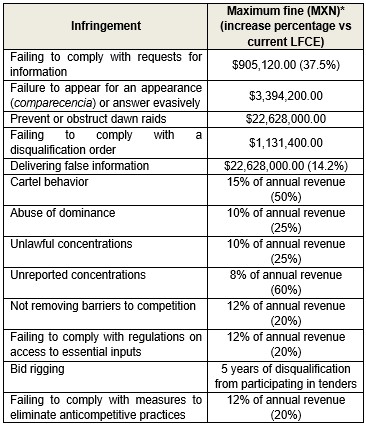
In cases of recidivism, the amount of the above-mentioned fines may double. Recidivism will be considered to exist when there is a final decision at the administrative headquarters, so that the corresponding sanction may be imposed even if there is a procedure pending resolution in court.
1. In the case of SMEs, the CNA Investigative Authority may file a complaint with the appropriate authorities to initiate a criminal investigation against the economic agents indicated in the opinion of probable responsibility, without the need for a definitive resolution. This will mean that economic agents may have to defend themselves simultaneously in an administrative and a criminal proceeding, as well as possible contradictory decisions in both procedures.
2. In certain cases, the CNA may bring individual or collective legal actions to seek redress for damages derived from monopolistic practices or illegal concentrations.
3. The possibility of economic agents offering security to lift the precautionary measures imposed on them is eliminated.
The CNA may certify compliance programs in the area of economic competition with the benefit of serving as a mitigating factor for the fines imposed by the CNA in the event of a violation. The certification will be valid for 3 years.
• The CNA will be a decentralized body of the Ministry of Economy with competition powers in all markets, including those related to telecommunications and broadcasting (currently in charge of the IFT), sectors in which it will coordinate with the new Agency for Digital Transformation and Telecommunications (the “ATDT”) and the CRT for specific procedures such as the determination of Preponderant Economic Agents, among others.
• The Plenary of the CNA will consist of 5 commissioners, elected by the President of the Republic and ratified by the Senate. Each commissioner will serve for 7 non-renewable years and will be appointed in a phased manner. The first CNA commissioners will be in office from their appointment and will conclude their assignment in a phased manner.
• The positions of each commissioner regarding issues resolved by the CNA should be public, thus seeking to promote greater transparency.
• The CNA will not be able to issue opinions on economic competition without prior request from the Federal Executive.
• Damage actions may be brought when the resolution determining the carrying out of monopolistic practices or illegal concentrations has been issued, rather than when this has caused a state.
• The CNA may give a hearing to the Federal Consumer Attorney's Office for possible harm to consumers as a result of anti-competitive practices.
• It is established that the activities carried out by State public companies and those indicated by the laws that are issued shall not constitute monopolies.
1. The CNA may determine the existence of predominant economic agents in the telecommunications and broadcasting sectors.
2. The CNA may impose on broadcasting and telecommunications concessions, after the opinion of the CRT, the obligation to include in their restricted television service (i) the news or public interest channels determined by the CNA and (ii) at least three channels whose content is predominantly from independent national programmers whose funding is mostly of Mexican origin. If it considers that these measures are insufficient, the CNA may order the disincorporation of assets from the economic agent in question.
• The CNA will continue the procedures initiated by COFECE and IFT in accordance with the legislation in force at the time of its initiation.
• All investigative procedures substantiated by the Investigative Authorities of COFECE and the IFT will be suspended from the date of entry into force of the Reform and will resume the day after the CNA Plenary is integrated, for the cases of COFECE, and the day after the full session of the CRT is integrated, for the cases of the IFT.
• The deadlines for merger notification procedures and the procedures followed in the form of a lawsuit before the CNA will not be suspended.
• Although there is no deadline for the Executive Branch to appoint the commissioners of the new CNA, due to COFECE budget cuts earlier this year (about 70% of its previous year's budget), we estimate that such appointment and establishment of the CNA Plenary will take place shortly.
Awards





